HP Stream 11 Review: A New Take On Low Cost Computing
by Brett Howse on December 17, 2014 8:00 AM ESTDisplay
The rise of smartphones and tablets has dramatically changed the display landscape, with practically all tablets having In Plane Switching (IPS) displays. IPS offers much better viewing angles and color reproduction compared to the standard laptop displays that use a Twisted Nematic (TN) based LCD. There has been the start of a push to IPS panels on notebooks, but far too many are still burdened with TN. The lower the cost of the device, the higher the probability it will have a TN panel - Chromebooks included. The HP Stream is one of the lowest priced notebooks available and as such, it is saddled with a TN LCD, and not a very good one at that. But, with the price point it has achieved, we must set our sights a bit lower.
With a resolution of 1366x768, the HP Stream 11 has the standard “HD” resolution and 16:9 aspect ratio of almost all notebooks under $500, and once again with this price we should not be shocked or outraged. Compromises must happen to reach lower prices, and the display is almost always one of the first to go. With the 11.6” diagonal dimension, this display comes in at 135 pixels per inch, which is actually higher than the standard 96 DPI Windows was founded on. It is not high DPI by any means, but it is what is expected at this price point.
With a fairly low resolution, there is no need for any sort of strange pixel arrangement, and as such we have a standard RGB stripe. The display has a matte finish, which causes some subpixel distortion.
To evaluate our displays, we utilize a custom workflow in SpectraCal’s CalMAN 5 software. To measure brightness and black levels, an i1Display Pro from X-Rite is used, and for color testing the X-Rite i1Pro spectrophotometer is leveraged.
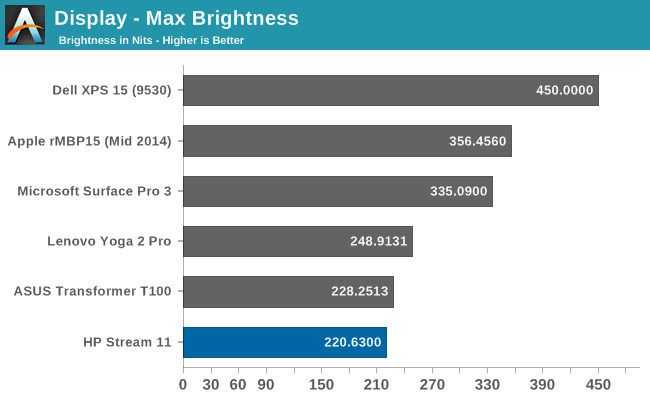
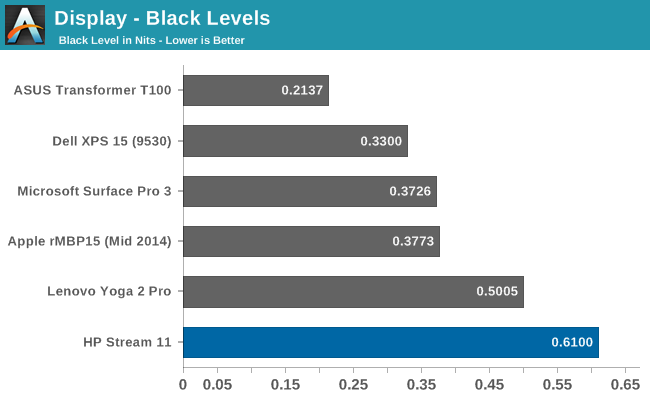
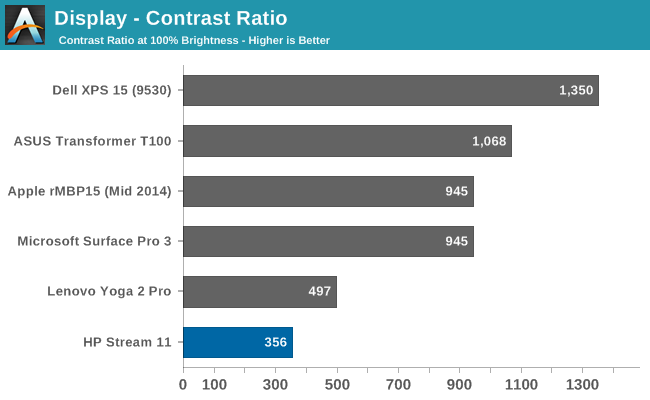
The HP Stream 11 is not a very bright display, but at 220 nits it is fine for indoor use. The matte finish would help somewhat for outdoor viewing, but would still make for a poor experience. High black levels result in a very poor 356:1 contrast ratio, which is further hampered by the poor viewing angles of the TN TFT.

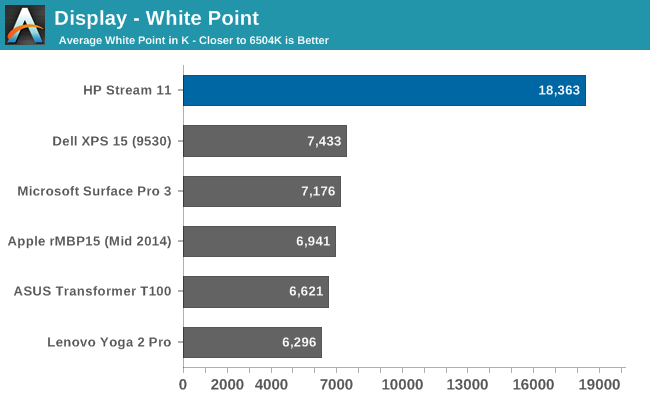
As you can see in the image, the blues in this display are ridiculously high, and the reds drop to nothing. This gives an absurd uncalibrated white point of 18363, when it should be as close to 6504 as possible. The grayscale accuracy is also far too high at 11.6.
When we perform our testing, we are targeting sRGB which is the standard color space for most web content. The HP Stream is not even close to the entire sRGB space, and the amount of drift on our saturation sweeps is very severe. The 100% blue and 100% red are both closer to the 80% mark than the 80% is, which makes the magenta very shifted and compressed. The overall score of 12.01 is very poor.
The colorchecker only confirms the bad news, with an overall score of 10.5. This panel is really poor. Not much more can be said. Calibration also did nothing for the display. It is difficult to calibrate a display to a particular color space when it cannot do the entire gamut. To have a standard, we calibrate to sRGB at 200 nits, and while the Stream 11 is bright enough for this, the LEDs are at practically maximum brightness which likely makes these results even worse.
We have been spoiled by an influx of high quality displays on devices lately. The HP Stream 11 does not continue this trend. It has a TN LCD which is quite terrible, and harkens back to the days of old. At the same time, some leeway should be given due to the price point of the laptop. Clearly HP had a $199 price point in mind and had to find savings to hit that price, and the LCD is always one of the first things on the chopping block. Still, this is even a poor display by poor display standards.







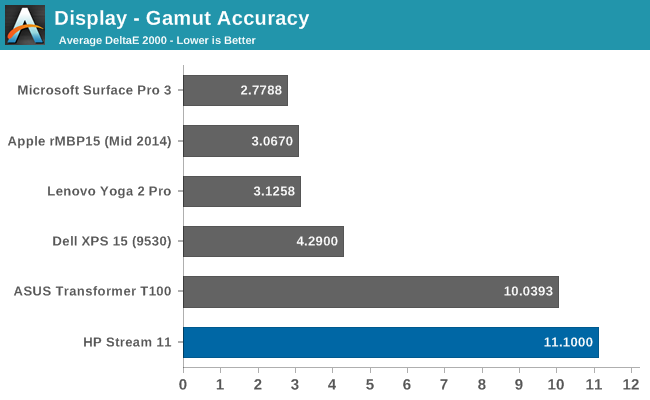








59 Comments
View All Comments
name99 - Wednesday, December 17, 2014 - link
It's interesting to compare against the iPad Air 2 which,for most benchmarks, comes out as 1.5 to 2x as good.I say this not as a "rah rah Apple" --- an iPad Air 2 is about 3 to 4x the price of this thing --- but more as a "who says ARM isn't appropriate for laptops?" I'd want rather more oomph from my laptop, which I run Mathematica on, but there certainly appears to be a market for which ARM levels of performance are acceptable. Which means hurdle number one has been overcome...
There are some remaining hurdles...
We need an OS. Ubuntu probably ain't gonna cut it. God knows what the new, panicky and flailing, MS will do. They could offer up Windows RT for this class of devices. Or is Win RT dead and buried? Chromebooks may continue their slow burn trajectory --- I don't think anyone can predict how those will play out.
And we need a CPU. Snapdragon 810 seems to be MIA for a few more months (and who knows how it will perform when it ships). The server level CPUs seem very inappropriate. But Denver is a serious possibility, and Samsung may one day ship an A57 Exynos that isn't embarrassing.
So I could see Chromebooks firing back with equivalent level HW, and higher performance in the form of a Denver CPU.
If Google could then get its head out of its ass long enough to
(a) make a deal with Citrix for a Citrix front end on Chromebooks that doesn't absolutely suck (one star on the Chrome Store! that's some fine going, Citrix!)
(b) get Android apps (pretty much all of them) to run on Chromebook
they might have a product that catches fire.
(But WITHOUT BOTH of these, I suspect they're relegated to the "meh, interesting but not for me" category.)
savagemike - Wednesday, December 17, 2014 - link
ChromeOS does not exactly restrict you to Google's ecosystem. And while this might have more onboard storage than typical ChromeOS devices - the paradigm is a bit different for ChromeOS. Onboard storage is not as necessary as it has traditionally been on Windows.Mobile-Dom - Thursday, December 18, 2014 - link
Is the Wireless card Mini PCIe? or is it soldered down? because im sure you can find 802.11ac Mini PCIec cards on ebay for like £25Brett Howse - Thursday, December 18, 2014 - link
Although I didn't crack mine apart, I believe it's mini PCI-E from what I could find.Yes, you should be able to change it, but that doesn't excuse the one put in there. Also when you're dealing with something with a $200 price point, saying "just add a better card yourself" and it's $30 means that you are now 15% over the original asking price. That's a lot. Add in a new wireless and a good SD card and you're going to be closer to $300 that $200 and then your options for other devices increases.
jabber - Thursday, December 18, 2014 - link
Well when I look at a customers laptop and I mention "Oh it's got Wireless N!" to a customer they will always say "what's that?"You spec according to the average Joe.
amdhunter - Thursday, December 18, 2014 - link
The wireless is horrible. I knew it was 1x1 when I bought it, but didn't expect it to be as bad as it is. It took a lot of playing around with my router to get around all the interference in my area, but most of the time I am tethered to my gigabit Ethernet adapter so it doesn't bother me much.From the breakdown manual, you can replace it, but I don't know if HP still blacklists cards or not.
greenwavelet - Wednesday, January 7, 2015 - link
The Stream, doesn't have Ethernet according to the specs.Are you using a USB3 Ethernet adapter for this?, you're still not getting anywhere near Gigabit speeds, not to mention you lose the single USB3 port for other devices (backup drive...)
This looks like a reasonable laptop as a standalone PC, but not suitable for any networking use more than browsing.
MrSpadge - Thursday, December 18, 2014 - link
Surprisingly good. Move to an IPS screen, quad core CPU (with silent fan) and 64 GB of NAND and it should easily sell for ~250$, with better WiFi and higher resolution maybe even 300$. It would be nice to have both options.Lolimaster - Thursday, December 18, 2014 - link
Considering that i get 60-90fps in league of legends with good old amd 790gx (2008) integrated gpu @1024x768 medium/high details, how bad can be intel graphics?Morawka - Friday, December 19, 2014 - link
its a shame none of these stream books have RJ 45 Ethernet. This is a perfect low cost laptop to use in the field fixing routers, AP's, and other networking gear.ATM i'm using a venue 8 pro with a USB OTG ethernet adapter. It's a pain in the ass to lug all that stuff around but it'll have to do until someone makes a decent laptop with RJ45 priced $200 or below